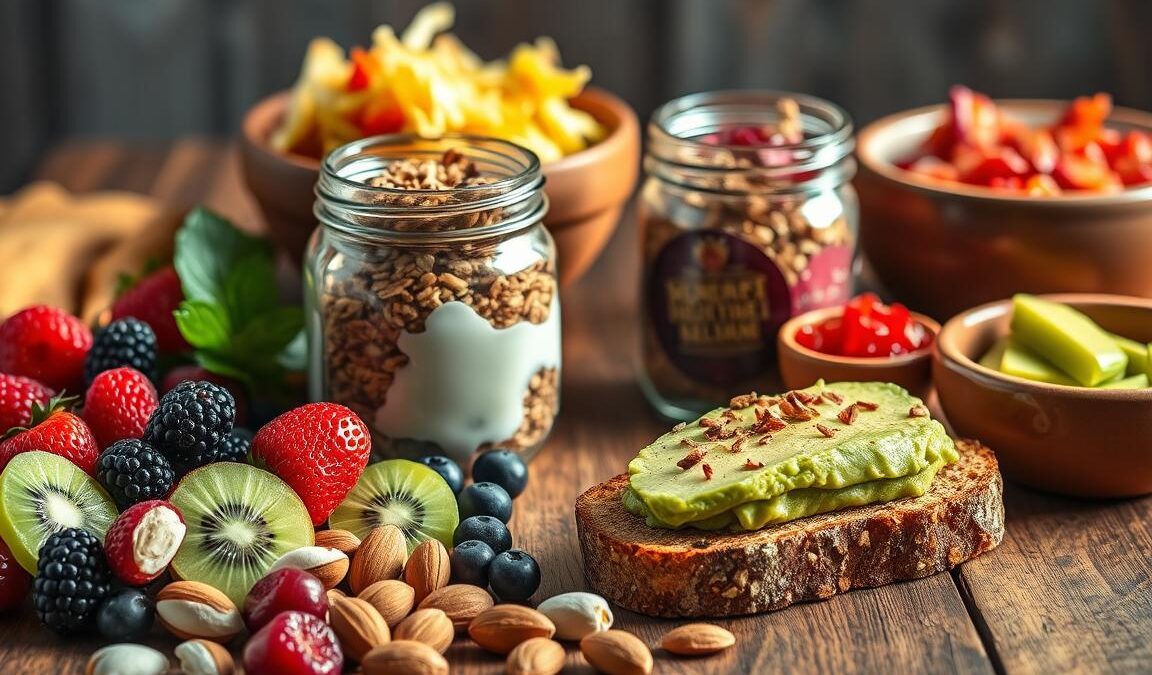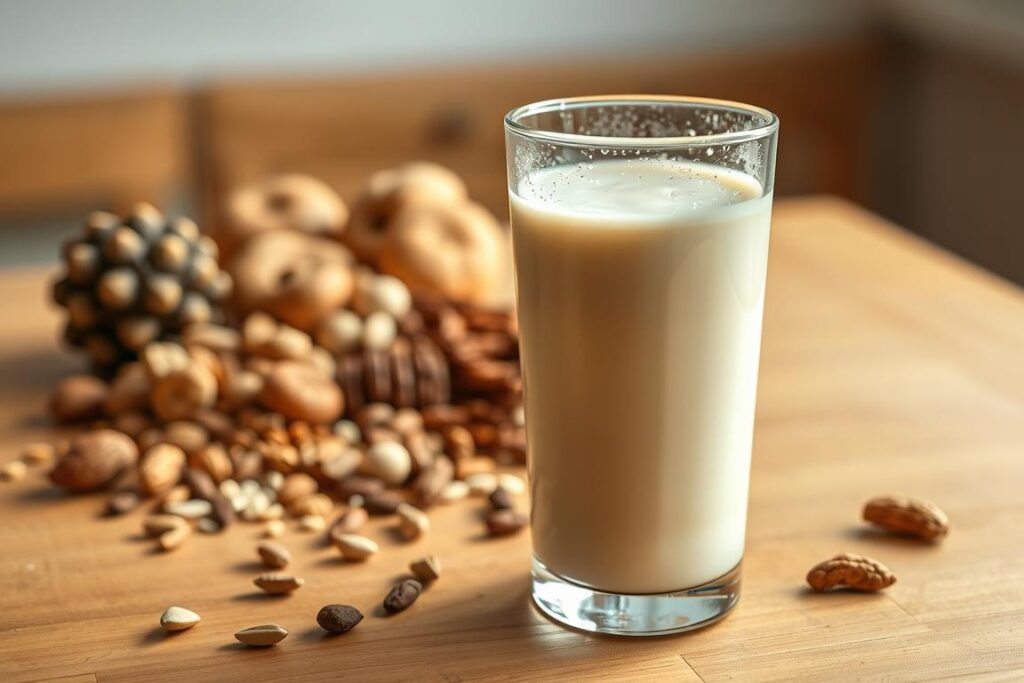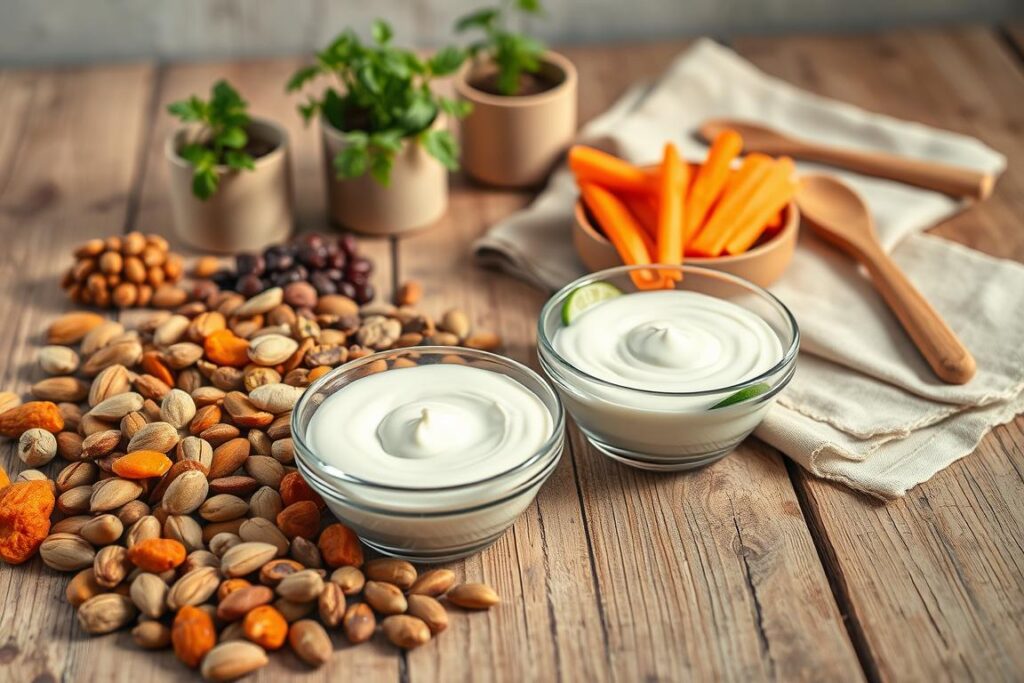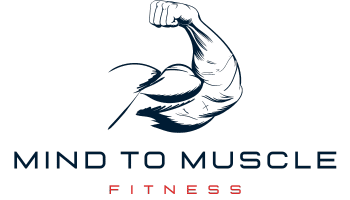
Top Gut-Friendly Post‑Workout Snacks for Digestion
You want gut-friendly post-workout snacks that help your body bounce back fast and without upset.
After hard exercise, aim to eat within 1–3 hours to restore energy and kickstart recovery. Focus on about 20–25 grams of quality protein plus easy carbs so you refill glycogen and support muscle repair.
Choose whole, minimally processed foods that digest well. Options like Greek yogurt with fruit, tuna and whole-grain crackers, or a protein smoothie give steady fuel and low GI stress.
Keep fat modest for satiety, spread protein through the day, and match your choice to the workout intensity and timing. Simple prep and smart portions make the plan practical for any schedule.
Key Takeaways
- Eat within 1–3 hours to maximize recovery and muscle repair.
- Target 20–25 g quality protein and include easy carbs for glycogen refill.
- Pick whole, minimally processed foods to protect digestion and health.
- Spread protein across the day for better use by the body.
- Match snack size and type to the length and intensity of your workout.
Why your recovery snack matters right now
Ready to recover from your workout? A targeted snack helps rebuild and refuel fast.
Why eat soon after exercise? Your muscles used glycogen and have tiny tears that need repair. Eating within 30–60 minutes speeds key recovery markers, though you have up to 1–3 hours.
The 4R’s keep it simple: rehydrate, refuel glycogen, repair muscle, rest. Combine protein with carbohydrates to restore glycogen and support functional capacity.
- Carbohydrates refill glycogen and energy stores so you feel steady.
- Protein supplies amino acids for muscle repair and growth.
- A little fats slow digestion just enough to keep you satisfied.
- Choose whole or minimally processed foods for better long-term health.
| Need | What to eat | Why it helps |
|---|---|---|
| Rehydrate | Water + electrolytes | Restores fluid balance and performance |
| Refuel | Simple carbs + whole grains | Replaces glycogen and energy stores |
| Repair | Lean protein or dairy | Delivers amino acids for muscle repair |
| Satisfy | Small healthy fats | Improves fullness without slowing the body too much |
Plan a quick option before you train. Ask: what did I do, when is my next workout, and what fits my schedule? Then pick a simple, planned snack to make recovery automatic.
The sweet spot for recovery: timing, macros, and digestion
When you eat after exercise matters as much as what you eat. Aim to fuel within 30–60 minutes for the biggest gains. If that window is missed, you still benefit up to three hours.
Simple targets help. Shoot for about 20–25 grams protein and pair it with carbohydrates to restore glycogen. Keep fats light so absorption isn’t slowed too much.
- Aim for the first hour; life permitting, up to 3 hours still helps recovery.
- About 20–25 grams protein supports muscle repair; add carbs to refill glycogen.
- Choose easy carbs and moderate fiber to avoid bloating—ripe banana, oats in small portions, or rice cakes.
- Prefer liquids like smoothies when appetite is low; they ease intake without discomfort.
| Focus | Practical choice | Why it helps |
|---|---|---|
| Timing | 30–60 minutes | Speeds repair and nutrient uptake |
| Macros | 20–25 g protein + carbs | Builds muscle and refills glycogen |
| Digestion | Low-fiber, mindful fats | Reduces GI upset and aids absorption |
Dairy and alt‑dairy winners: creamy, protein‑rich, and easy on the gut
Looking for creamy, fast-absorbing options that support recovery and sit easy in your stomach?
Greek yogurt with berries gives concentrated protein and live cultures. Top a cup with a handful of berries, a sprinkle of granola, and a few seeds for carbs, antioxidants, and crunch.
Cottage cheese combos work if you prefer savory or tangy. Try cottage cheese with pineapple or peaches for quick carbs and an enzyme boost that may ease digestion.
Chocolate milk plus a lean meat stick is a classic carb-plus-protein pairing you can chug when time is tight. Milk delivers rapid energy and helps repair muscle.
Protein smoothies blend protein powder with soy or dairy milk, frozen fruit, and a handful of spinach. Stir in a spoon of peanut butter or almond butter for extra calories without bulk.

| Option | Why it helps | Serving tip |
|---|---|---|
| Greek yogurt + granola | Protein, probiotics, carbs | Use 1 cup yogurt; add ¼ cup granola |
| Cottage cheese + fruit | Easy protein, quick carbs, bromelain | Top ½ cup with pineapple or peaches |
| Smoothie (milk + powder) | Fast calories, micronutrients | Blend 1 scoop protein powder + 8 oz milk |
Savory gut-friendly post-workout snacks you can assemble fast
Need a portable, protein-forward choice you can make in minutes? These savory builds are practical, travel well, and support fast muscle recovery without extra fuss.
Tuna salad on whole wheat crackers
What to do: Mix a small can of tuna with Greek yogurt, a squeeze of lemon, and pepper.
Serve on whole wheat crackers for steady carbohydrates and added fiber. Aim for a portion that delivers ~20-25 grams protein by using a full small can.
Turkey or chicken wrap with veggies
What to do: Layer palm-sized poultry, a whole grain tortilla, cucumber, and bell pepper.
Roll tight. This packable option gives lean protein, complex carbs, and micronutrients to help your body after a workout.
Quinoa salad with chopped vegetables
What to do: Combine cooked quinoa, chopped veggies, a splash of olive oil and lemon.
Quinoa adds complete protein and steady carbs. Add a little avocado if you need more fats and calories.
- Keep dressing light to protect digestion.
- Pack salt and water to aid rehydration.
- Use precooked grains or rotisserie chicken to save time.
| Option | Key benefit | Portion cue |
|---|---|---|
| Tuna + crackers | Budget-friendly protein | 1 small can (~20–25 grams protein) |
| Turkey/chicken wrap | Lean protein + carbs | Palm-sized serving of meat |
| Quinoa salad | Complete protein, steady energy | ½–1 cup cooked quinoa |
Simple whole‑food pairings for balanced energy and digestion
Keep recovery simple with whole foods that travel well and fuel you steadily. These pairings give protein, modest carbs, and gentle fats you can pack in a bag.
Hard-boiled eggs with avocado slices and a pinch of salt
Hard-boiled egg is a zero-drama protein. Each egg supplies about 6–7 grams of protein and carries no prep fuss.
Pair two eggs with avocado slices for healthy fats and minerals. Salt lightly. Add a piece of fruit for carbs if you need extra energy.
Homemade trail mix with nuts, seeds, and a little dried fruit
Make your own mix so you control sugar and sodium. Lean on almonds, pumpkin seeds, and a small handful of raisins or cherries.
Portion a 1/4–1/3 cup scoop. Want creamier options? Try a spoon of peanut butter with apple slices instead.
- Travel tip: Pre-portion eggs and trail mix into small containers.
- Sensitive stomach: Skip dried fruit and add extra seeds and a few crackers.
- More protein: Pair with yogurt or a lean meat stick when needed.
| Pairing | Portion | Why it helps |
|---|---|---|
| Eggs + avocado | 2 eggs + ¼ avocado | Compact protein, steady fats, minerals |
| Trail mix | ¼–1/3 cup | Controlled carbs, healthy nuts and seeds |
| Apple + peanut butter | 1 tbsp PB + 1 apple | Creamy carbs and added protein |
Smart swaps for sensitive stomachs and different diets
If your stomach is sensitive, small swaps can keep recovery simple and steady. What can you change without losing the benefits of protein, carbohydrates, and light fats?

Low‑FODMAP‑aware choices
Pick a ripe banana, rice cakes, and lactose‑free yogurt to get quick carbs and some protein without the bloat. These options support intake and steady digestion.
Dairy‑free and vegan options
Choose soy yogurt, hummus boxes, or plant protein shakes. They give reliable protein and keep recovery on track when you avoid milk or cheese.
Gluten‑free or lower‑carb tweaks
Swap whole wheat crackers for sprouted or gluten‑free crackers. For lower carbs, add extra eggs and seeds, and favor potatoes or rice if your stomach prefers them.
- Peanut not tolerated? Use almond or sunflower choices instead.
- Keep fats light: olive oil, avocado, or tahini work well.
- Aim for protein every time so muscle growth and recovery stay consistent.
| Need | Swap | Why it helps |
|---|---|---|
| Low‑FODMAP carbs | Ripe banana, rice cakes | Quick energy with less fermentable fiber |
| Dairy‑free protein | Soy yogurt, plant shake | Maintains protein intake without lactose |
| Gluten‑free carbs | Sprouted/GF crackers, rice | Easier digestion for those sensitive to wheat |
| Lower‑carb | Extra eggs, seeds | Protein and fats with minimal carbohydrates |
How to time and size your post‑workout snack for best results
How you time and size your recovery bite can change muscle repair and next‑session energy. Eat within 30–60 minutes when possible. That window improves amino acid uptake and speeds glycogen refill after exercise.
Match the snack to your session
Endurance day: Prioritize carbohydrates to refill glycogen. Add a moderate protein hit of about 20–25 grams protein for repair and to limit muscle breakdown.
Heavy strength day: Push protein toward the top of that range. Include carbs so you restore energy and support growth between lifts.
Mixed session: Balance carbs and your protein anchor. A small fat helps staying power without slowing digestion too much.
Target ranges and decision rules
- Aim for roughly 20–25 grams of protein and a fist-sized portion of carbs for most workouts.
- If your next workout is soon, pick fast-digesting drinks or light solids.
- If you have hours before the next session, choose a fuller whole‑food option with a thumb-sized fat portion.
- Use simple cues: one scoop (protein), a fist (carbs), a thumb (fats).
| Session type | Protein (grams) | Carbohydrate focus |
|---|---|---|
| Endurance | 20–25 | Higher carbs to refill glycogen |
| Strength | 22–25 | Moderate carbs for energy and growth |
| Mixed | 20–25 | Balanced carbs + small fat for staying power |
Watch performance and soreness the next day. If you underperform or feel extra soreness, increase carbs or total protein slightly. Keep 3–5 reliable options for each workout type so timing and sizing become automatic.
Quick prep playbook: on‑the‑go, budget‑friendly, and repeatable
Set yourself up for steady energy by prepping small, repeatable packs. Start with clear staples you trust. Pick two flavors and two formats. Rotate them across the week.
Packable combos you can grab in a minute:
- Build a bento: single-serve yogurt or cottage cup, whole-grain crackers, a fruit, and a handful of nuts or seeds.
- Keep tuna pouches, meat sticks, and peanut butter packets in your bag for reliable protein and quick carbs.
- Stash a chocolate milk and a meat stick in the fridge for a fast combo after a hard workout.
Make‑ahead basics that save time:
- Boil a batch of eggs on Sunday. Peel into containers for the week.
- Portion yogurt and granola into small tubs so you can top and go.
- Pre-mix trail mix with nuts, seeds, a little dried fruit, and store in a jar.
- Keep a shaker and protein powder in your car or office. Add milk or water when you need a quick drink.
| Prep | What to pack | Why it works | Quick step |
|---|---|---|---|
| Bento | Yogurt, crackers, fruit, nuts | Balanced carbs, protein, fats | Portion into a box each morning |
| Pantry stash | Tuna pouches, peanut butter packets | Long shelf life, easy protein | Keep on a low shelf; grab before you leave |
| Make-ahead | Boiled eggs, trail mix | Fast protein and steady energy | Prep Sunday; refill weekly |
| On-the-go shake | Protein powder, milk or water | Rapid recovery calories | Store scoop and shaker together |
Write a two-line shopping list you repeat weekly. Check your bag before you leave. Small prep wins add up to consistent nutrition and better energy all day.
Conclusion
Make recovery automatic: pick two go-to post-workout snack options you can assemble fast and repeat each day.
Anchor each choice with about 20–25 g of protein and add carbs to refill glycogen and energy stores. Use simple foods like Greek yogurt with berries, cottage cheese with fruit, a shaker with powder and milk, or eggs with avocado.
Keep whole wheat or gluten-free crackers, a jar of nut butter, and a cup of yogurt on hand. These small habits protect digestion and help muscle growth and repair.
Which two will you prep this week so recovery is simple and consistent after every session?



